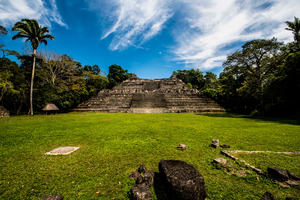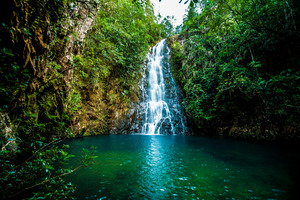With steamy rainforests, jaguars and toucans, mysterious Mayan temples and the hypnotic sound of Garifuna drums, Belize is small but packed with surprises.
 The only English-speaking country in Central America and known as British Honduras until 40 years ago, tiny Belize has the Queen’s head on its banknotes but is still relatively undiscovered by the British.
The only English-speaking country in Central America and known as British Honduras until 40 years ago, tiny Belize has the Queen’s head on its banknotes but is still relatively undiscovered by the British.
So I am delighted to see that Belize is being tipped as a must see for 2018 by various travel gurus, at long last seduced by its heady mix of lush rainforest, waterfalls, amazing coral reefs, ancient buildings, diverse culture and colourful wildlife.
I fell in love with Belize early last year when my scuba diving husband was drawn to its Blue Hole and barrier reef – at 185 miles long it is the longest in the Western Hemisphere. Above the water I found a country with all the tropical Caribbean trappings of sun, sand and palm trees but with a distinct personality all of its own. We returned for a month just before Christmas, escaping the British winter for temperatures of 80 degrees and a warm welcome.
 It is only 8,867 square miles in size and with a population of 388,000 the main attraction is its untouched natural environment. You don’t find any big resorts here, but you can take your pick of luxurious eco-lodges, quirky guesthouses and small friendly hotels. Its tallest building is a Mayan temple, also depicted on the label of its national beer Belikin, and it national bird is the flamboyant toucan. Life here is unhurried and although ads for adventure tours such as cave diving and zip-lining abound this is also a place for kicking back and enjoying gentle pursuits such as bird watching, drinking in the fascinating Mayan architecture, relaxing on the beach and watching the sunset.
It is only 8,867 square miles in size and with a population of 388,000 the main attraction is its untouched natural environment. You don’t find any big resorts here, but you can take your pick of luxurious eco-lodges, quirky guesthouses and small friendly hotels. Its tallest building is a Mayan temple, also depicted on the label of its national beer Belikin, and it national bird is the flamboyant toucan. Life here is unhurried and although ads for adventure tours such as cave diving and zip-lining abound this is also a place for kicking back and enjoying gentle pursuits such as bird watching, drinking in the fascinating Mayan architecture, relaxing on the beach and watching the sunset.
Cayes
 Caye Caulker, possibly my favourite spot in Belize, is one of 400 cayes or small islands. Its unofficial motto is Go Slow – a message no doubt unheeded by the 18th century pirates who rocked up here to seek refuge. Today you are more likely to bump into an ageing hippy that looks as if he has been here since the 1960s or a lazy Belizean iguana crossing the road. Caye Caulker sums up Belizean charm – quirky, eccentric and as no cars are allowed, only golf carts and bicycles will interrupt your evening stroll to sip a cocktail and see the sun set at the Lazy Lizard on the Split. Here we snorkelled and swam with sharks and stingrays.
Caye Caulker, possibly my favourite spot in Belize, is one of 400 cayes or small islands. Its unofficial motto is Go Slow – a message no doubt unheeded by the 18th century pirates who rocked up here to seek refuge. Today you are more likely to bump into an ageing hippy that looks as if he has been here since the 1960s or a lazy Belizean iguana crossing the road. Caye Caulker sums up Belizean charm – quirky, eccentric and as no cars are allowed, only golf carts and bicycles will interrupt your evening stroll to sip a cocktail and see the sun set at the Lazy Lizard on the Split. Here we snorkelled and swam with sharks and stingrays.
Blue Hole
 Belize’s Blue Hole is an underwater sinkhole visible from space. At over 300 metres (984 ft.) across and 125 metres (410 ft.) deep it is the world’s largest natural formation of its kind. Expect to see nurse sharks, giant groupers, and several types of reef sharks such as the Caribbean reef shark and the Blacktip shark. Jacques Cousteau made an investigation of the Great Blue Hole and the Belize atolls in the 1970s which kick-started its popularity with scuba divers from all over the world.
Belize’s Blue Hole is an underwater sinkhole visible from space. At over 300 metres (984 ft.) across and 125 metres (410 ft.) deep it is the world’s largest natural formation of its kind. Expect to see nurse sharks, giant groupers, and several types of reef sharks such as the Caribbean reef shark and the Blacktip shark. Jacques Cousteau made an investigation of the Great Blue Hole and the Belize atolls in the 1970s which kick-started its popularity with scuba divers from all over the world.
And as the country has the second largest barrier reef in the world there are also beautiful areas of reef teeming with sea life. Last year saw the 20th anniversary of the Belize barrier reef’s designation as a world heritage site, only one of 47 sites around the world with this status.
People
One of the great pleasures of visiting Belize is meeting the local people from different cultural traditions, Mestizo, Creole, Maya and Garifuna. We were in San Pedro on Garifuna Settlement Day in November, which celebrates the arrival of the Garifuna people to the country with parades, drumming and dancing throughout the day.
Transferring from the cayes by ferry we took the charmingly named and scenic Hummingbird Highway from Belize City to the southern seaside town of Dangriga, the country’s cultural capital with its Garifuna drumming centre and on to lovely Hopkins fishing village, now home to some upmarket hotels but still with the quaint, simple style that defines the area. En route we saw some Mennonite people around Spanish Lookout. This group of traditionally dressed conservative people now contribute to the agricultural economy of the country.
Wildlife
 The cockscomb Basin Wildlife sanctuary is just off the Hummingbird Highway, one of Belize’s best places to see jaguars as well as some 250 species orchids and 300 species of birds. Other breath-taking spots include Guanacaste National park, named after the imposing Guanacaste trees, some over 100 feet high and habitat for hundreds of birds.
The cockscomb Basin Wildlife sanctuary is just off the Hummingbird Highway, one of Belize’s best places to see jaguars as well as some 250 species orchids and 300 species of birds. Other breath-taking spots include Guanacaste National park, named after the imposing Guanacaste trees, some over 100 feet high and habitat for hundreds of birds.
But just wander around the cayes and the rivers for the sheer delight of spotting up close Belizean rays leaping out of the water at dawn, tiny seahorses dangling in rock pools, the gorgeous Caribbean brown pelican swooping for fish or baby crocodiles hiding in the mangroves.
Accommodation
 Film director Francis Ford Coppola loves the steamy jungle of Belize and was inspired to buy an island here. He now owns three eco lodges here including the gorgeous luxury Blancaneaux Lodge.
Film director Francis Ford Coppola loves the steamy jungle of Belize and was inspired to buy an island here. He now owns three eco lodges here including the gorgeous luxury Blancaneaux Lodge.
At the other end of the scale there are hundreds of affordable and comfortable small hotels. Hostels abound too – my 64 year old sister in law had a great time in hostels accommodating all ages in San Pedro, San Ignacio and Caye Caulker.
This is a delightful country ripe for exploring, and because of its position is a great base for taking in neighbouring Guatemala or Mexico, both easily accessible by ferry or even bus.
More information
Getting There: Belize is located in Northern Central America facing the Caribbean Sea bordering Mexico to the north and Guatemala to the south. There are no direct flights from the UK. Most flights to Belize City are via the USA (Miami, Houston, Atlanta, Dallas and Newark) Guatemala or Cancun. Once in Belize City comfortable ferries take visitors around the country or small aircraft fly between the main points of interest. As Belize is a small country you can travel from east to west or North to South in about two hours.
 Language: English, but also Kriol (English based language with African roots) You will also hear Spanish, Maya and Garifuna languages spoken
Language: English, but also Kriol (English based language with African roots) You will also hear Spanish, Maya and Garifuna languages spoken
Time Zone: GMT-6
Climate: Subtropical with average temperature of 80 F. Dry season from December to May and wet season June to November
Currency: Belizean Dollar but US dollars widely accepted











